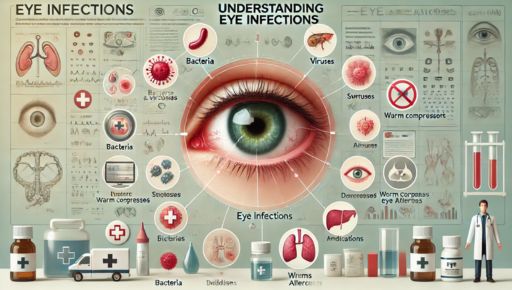Eye infections can range from mild irritations to serious conditions that may cause long-term damage if left untreated. Whether you’re experiencing redness, discomfort, or vision issues, understanding the symptoms, causes, and treatments for eye infections is essential to maintaining eye health. In this article, we’ll dive into everything you need to know about eye infections, from common causes to preventative measures, and available treatments.
What is an Eye Infection?
An eye infection occurs when the tissues of the eye become inflamed or irritated due to the presence of harmful microorganisms such as bacteria, viruses, or fungi. The infection can affect various parts of the eye, including the cornea, conjunctiva, eyelids, and the surrounding areas.
In most cases, eye infections are treatable, but if not properly managed, they can lead to complications that might cause long-term vision problems. Therefore, understanding the symptoms and knowing when to seek medical attention is crucial.
Common Types of Eye Infections
There are several types of eye infections, each with its own symptoms and treatment approach. The most common types include:
1. Conjunctivitis (Pink Eye)
Conjunctivitis, commonly known as pink eye, is one of the most common and contagious eye infections. It occurs when the thin layer of tissue covering the white part of the eye (the conjunctiva) becomes inflamed. Symptoms typically include:
- Redness in the white of the eye
- Itching or burning sensation
- Watery or thick discharge
- Crusting of the eyelids, especially in the morning
Pink eye can be caused by bacteria, viruses, allergens, or irritants like smoke or chemicals. Viral conjunctivitis is the most contagious form, spreading through respiratory droplets, contaminated surfaces, or direct eye contact.
2. Blepharitis
Blepharitis is an inflammation of the eyelids, typically caused by bacterial infection or clogged oil glands. It results in red, swollen eyelids and can lead to discomfort, burning sensations, or crusting of the eyelashes. Though not highly contagious, blepharitis can be persistent if not treated.
3. Keratitis
Keratitis is an infection of the cornea, which can be caused by bacteria, viruses (such as the herpes simplex virus), or fungi. This type of eye infection is serious and can lead to vision loss if untreated. Symptoms of keratitis include:
- Eye pain or soreness
- Sensitivity to light
- Blurry vision
- Redness and tearing
People who wear contact lenses are particularly at risk of developing keratitis.
4. Stye (Hordeolum)
A stye is a small, painful bump that forms at the edge of the eyelid due to a bacterial infection of the oil glands. It is often accompanied by redness, tenderness, and swelling of the eyelid. Styes can be caused by poor hygiene, blocked oil glands, or rubbing the eyes with dirty hands.
5. Uveitis
Uveitis refers to inflammation of the middle layer of the eye (the uvea). It can be caused by infections, autoimmune disorders, or trauma. Symptoms include eye redness, pain, blurred vision, and sensitivity to light. Uveitis is a serious condition that requires immediate medical attention to prevent permanent vision damage.
Symptoms of Eye Infections
The symptoms of an eye infection can vary depending on the type of infection, but some common signs include:
- Redness in one or both eyes
- Discharge or drainage from the eye
- Swelling around the eyes
- Pain or tenderness in the eye area
- Blurred vision or difficulty seeing clearly
- Sensitivity to light
- Itchy or gritty feeling in the eye
- Swollen eyelids
If you experience any of these symptoms, it’s important to monitor your condition and seek medical advice, particularly if the symptoms worsen or don’t improve.
Causes of Eye Infections
Eye infections can be caused by a variety of factors, including:
1. Bacteria and Viruses
The most common culprits behind eye infections are bacteria and viruses. Bacterial infections such as those caused by Staphylococcus or Streptococcus bacteria are often the cause of pink eye and styes. Viral infections, especially those caused by adenovirus, can also result in conjunctivitis and other viral eye infections.
2. Fungi and Parasites
Though rarer, fungal and parasitic infections can affect the eyes, particularly in individuals with weakened immune systems. Fungal keratitis, for instance, is commonly seen in people who wear contact lenses and have exposure to contaminated water.
3. Allergies and Irritants
Environmental allergens like pollen, dust, and pet dander can cause allergic conjunctivitis. Irritants such as smoke, pollution, or chemicals can also inflame the eyes, leading to irritation and infection.
4. Poor Hygiene
Touching your eyes with dirty hands or not properly cleaning contact lenses can introduce harmful microorganisms to the eyes, increasing the risk of infection. It’s important to maintain good hygiene practices, especially if you wear contact lenses.
5. Injury or Trauma
Physical injury or trauma to the eye, such as scratches on the cornea or foreign objects getting into the eye, can lead to infections if not properly treated.
Treatment Options for Eye Infections
The treatment for an eye infection will vary depending on the type and severity of the infection. Common treatment methods include:
1. Antibiotic or Antiviral Medications
For bacterial eye infections, doctors may prescribe antibiotic eye drops or ointments to eliminate the infection. In cases of viral conjunctivitis, antiviral medication may be necessary, especially if the herpes simplex virus is involved.
2. Warm Compresses
For conditions like blepharitis or styes, warm compresses can help reduce swelling and promote healing. Applying a warm, damp cloth to the affected eye for several minutes a few times a day can alleviate symptoms and speed up recovery.
3. Artificial Tears
If you have dry eyes or are experiencing irritation from an infection, artificial tears or lubricating eye drops can provide relief. These drops help soothe the eyes and reduce discomfort.
4. Steroid Medications
In more serious cases of eye infection, particularly those involving inflammation, a doctor may prescribe steroid medications to reduce swelling and pain. However, these are usually reserved for more severe infections, as steroids can increase the risk of other eye issues.
5. Surgical Treatment
In rare cases of severe keratitis or uveitis, surgery may be required to correct damage caused by the infection, or if the infection does not respond to medication.
How to Prevent Eye Infections
While some eye infections are unavoidable, there are several measures you can take to reduce the risk of getting an infection:
- Wash your hands regularly and avoid touching your eyes with dirty hands.
- Disinfect contact lenses and follow proper lens care instructions.
- Avoid sharing personal items like towels, makeup, or eye drops.
- Remove makeup before going to bed to avoid eye irritation.
- Stay away from infected individuals to prevent the spread of viral or bacterial infections.
- Wear protective eyewear to prevent injury or exposure to harmful substances.
Conclusion
An eye infection can cause discomfort and disrupt your daily activities, but with early detection and proper treatment, most infections can be resolved without lasting effects. If you experience symptoms of an eye infection, seek medical advice to ensure timely and appropriate treatment. By practicing good hygiene and protecting your eyes from irritants and injury, you can help prevent eye infections and maintain optimal eye health.



